

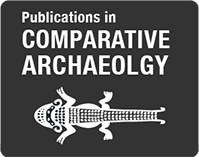

Our Series
We publish books of various kinds on comparative archaeological research in any part of the world. In particular, we focus on primary reports of archaeological research--reports that reach conclusions of broad enough importance to be of interest for comparative studies and that support their conclusions with detailed primary data and full accounts of the analyses that connect these data to the conclusions. Some of these reports appear in one of two series initiated by the former Latin American Archaeology Publications: Memoirs in Latin American Archaeology has a larger page size and a format designed to accommodate longer works, while Latin American Archaeology Reports has a smaller page size and a format more suitable for shorter works. A separate series: Comparative Archaeology, focused on archaeological research conducted in, across, and outside Latin America follows the Memoirs formats, as appropriate.
As information technology has rapidly evolved, we are making use of the opportunities offered by digital publication. Our aim is to pioneer new forms of organizing archaeological data for publication that exploit both the advantages of traditional book formats as well as the advantages of the Internet. In general we seek to make books smaller, more economical, and more synthetic and to deliver large amounts of detailed primary data digitally to complement the printed books. The Comparative Archaeology Database is the open-access online home of these digital datasets. All of our printed books are available for purchase in traditional soft cover editions. They are all also available as open-access PDF files for free download.
We are eager to discuss potential publications with authors relatively early in the process, so that we can collaborate with them in crafting a strategy for complementary paper and digital presentation of their work. Publication projects are reviewed by our own editorial committee, and outside reviewers, as needed. Interested authors are encouraged to contact Elizabeth Arkush to discuss publication of their work.

Matters of Style
Once a manuscript has been approved for publication by the Center's Editorial Committee, we ask authors to provide print-ready (clearly written and stylistically correct text) for both traditional and digital components of a publication. Compactness and directness of expression is strongly encouraged.
Authors should follow the Society for American Archaeology's Style Guide (sections 3.3, 3.4, and 3.12, which deal with textual elements, in-text citations, and references). Their Style Guides (available in both, English and Spanish) are revised from time to time, but they can be found listed under their publications section for American Antiquity and Latin American Antiquity. Particularly useful guidance is found in:
- Section 3.3.2, Numbers and dates
- Section 3.3.3, Metric measurements
- Section 3.3.5, Radiometric ages and dates
- Section 3.3.6, Quotations
- Section 3.3.9, Capitalization
- Section 3.3.11, Abbreviations
- Section 3.3.12, Accents and Diacritical Marks
Please do not use footnotes or endnotes in any text, as we follow the author-date system as defined in the Chicago Manual of Style, which is an additional useful reference to consult in general.
Manuscript Preparation for Books
Text does not need to be formatted, because such formatting will be removed later in the publication process. When accepted and ready for publication, text, of course, should be submitted in digital form. Generally a word processor document works best (DOC or DOCX files).
Once a manuscript has been accepted with final revisions, it is final; no further changes can be made. We expect to receive separate text files (one per chapter, one for bibliographic references). Similarly, front matter content should be submitted as separate files: title page, table of content, one master list of figures, one master list of tables, as well as a preface and an acknowledgments if needed/desired.
Please adhere to the following rules in preparing text files destined for book publication.
- DOs:
- Select one font for all the text files
- Use a font size large enough to be read with ease (this will depend on the font chosen--we suggest Arial 10-point or Times New Roman 12-point as equivalent examples).
- Single-space all text.
- Center the chapter title on the top of each first page.
- If a chapter is written by a different author(s), such as in edited volumes, list the author(s) name(s) under the title, as right-justified text.
- If the text has sub-headings, please note that we allow up to three levels (unlike the SAA Style Guide's two levels). Please format them as follows: the first level heading should have the text in bold and centered; the second level heading should have the text in bold, and left justified; and the third level heading should have the text in italics, and left justified.
- Format regular text paragraphs to be left justified (not fully-justified).
- Use a single return at the end of each paragraph, not two.
- Insert page numbers on all pages, beginning with 1 for the first page in each chapter file.
- Prepare the "list of captions" separately from the main chapter text. Captions should be mostly descriptive of the figure (one sentence or two short sentences usually work well; e.g., "Figure 1.1. Map of the Regional Settlement Survey, with current district subdivisions."). A long explanation or analysis text should not be included in figure captions; it goes in the main text.
- For the bibliography/references cited, make the author's name one paragraph, and the information about the work a second paragraph. This paragraph about the work should begin with the publication year, followed by only a single space, not a <Tab> or any other character. This reflects the CCA publication series style, and it is the only style deviation from the new SAA Style Guide issued on December 2023.
- DON'Ts:
- Do not include any tables or graphics in the file; submit them individually as separate files (see instructions below).
- Do not divide words at the ends of lines (i.e., turn off automatic hyphenation).
- Do not use returns for any purpose other than to start a new paragraph.
- Do not use returns to force text onto the next line or page.
- Do not begin paragraphs with tabs or spaces to cause indentation. Try not to use tabs at all. If hanging indentation is used for bulleted lists, do it with bullet style settings, not with returns, tabs, or spaces.
- Do not use multiple spaces together or tabs to create extra space in any context.
- Do not use more than one space after periods at the end of sentences.
- Do not use boldface and multiple fonts in the main text. Boldface is reserved exclusively for the sub-headings.
- Do not use footnotes or endnotes.
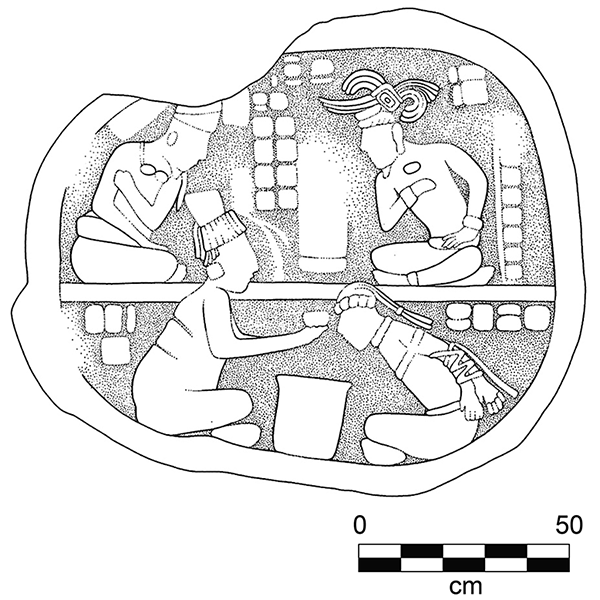
The line drawing above was printed on one column of text (maximum width of 3").
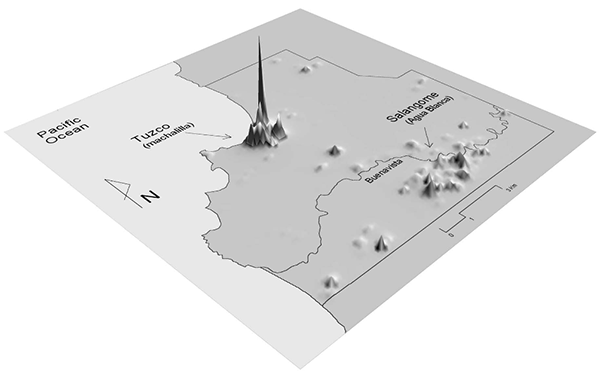
The isometric graph above was printed across the two columns of text (maximum width of 6.75").
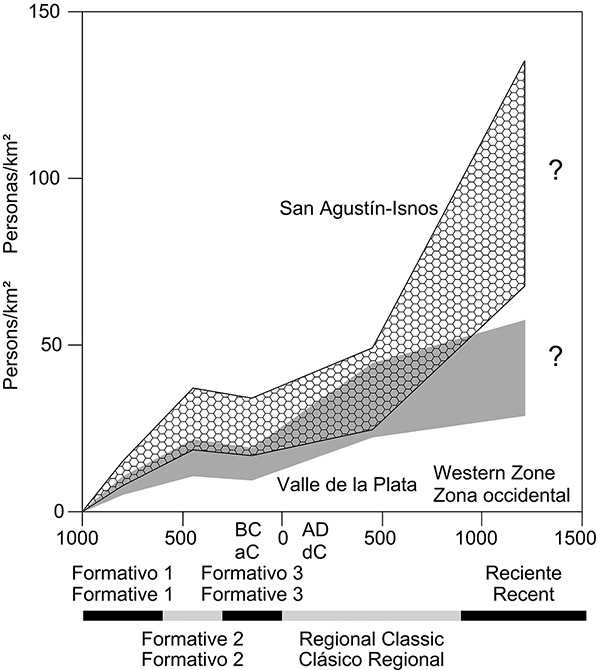
The estimated population density graph above is about 4" wide, extending about one inch onto the second column of text. Note the use of terms in two languages.
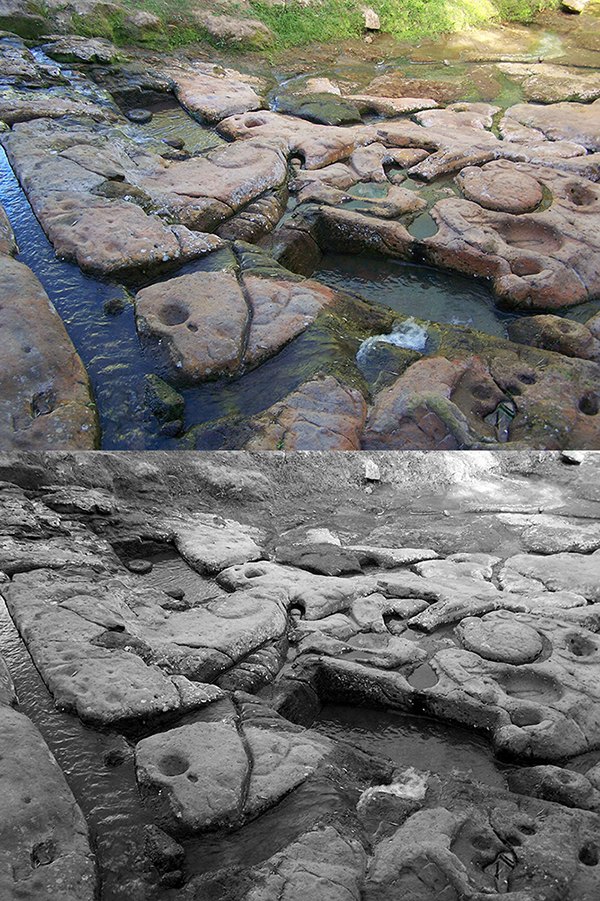
Color and B&W versions of the same photograph. The B&W image was placed in the printed Memoir, and the color version on the PDF file. Both occupied the same space across two columns of text.
Preparation of Figures for Books
Graphical material should never be included in the text file. All figures should be numbered in a single sequence. That is, we call them all "figures" (there are no "maps," "charts," "photographs," or "plates.")
The most convenient numbering scheme starts over in each chapter (Figure 1.1, 1.2, etc. in Chapter 1; Figure 2.1, 2.2, etc. in Chapter 2). All figures must be referred to in the text. The first figure referred to in the Chapter 1 text is Figure 1.1; the second referred to is Figure 1.2; etc.
Line drawings should be submitted in digital form. For black and white line art, submit either bitmap or gray-scale TIF files. Resolution should be 1200 pixels per inch (ppi), calculated at the size the figure will appear in the book. That is, if the illustration is finally intended to appear 5 inches wide by 4 inches high, then the TIF file must be 6000 pixels wide and 4800 pixels high. If your TIF file is 1200 pixels wide and 960 pixels high it has only 240 ppi of resolution this low resolution case cannot be remedied by simply opening the TIF file with Photoshop and changing the resolution to 1200 ppi. It will be necessary to go back to Illustrator or AutoCAD or whatever program produced the illustration and save a new TIF file with sufficient resolution.
By following this guidelines, the files will certainly be very large. When saving them, do not use compression methods to make smaller files. We need them uncompressed. They can all be collectively compressed into one file after saving the individual figures (for example into .zip or .rar files) for a more convenient submission to us.
Plan carefully for the size at which figures will finally appear. The Report format, can accommodate figures up to 5.25 by 8 inches (13.3 by 20.3 cm). All other series we publish can accommodate illustrations up to 6.75 by 9.5 inches (17.2 by 24 cm). These dimensions refer to the entire printable area of a page. But do please note that space for captions must be subtracted from these dimensions (keeping also in mind that captions will double in size as they will be bilingual).
Larger illustrations could be divided across two facing pages if truly needed, providing a usable space (including caption) of 13.5 by 9.5 inches (34.4 by 24 cm)-- or 10.5 by 8 inches (26.7 by 20.3 cm) in the Report format. However, the illustration may not be fully readable where pages meet, so we do not particularly encourage this.
It is often convenient for the reader if comparable line art is all at the same scale. For example, a series of plans of different excavated areas that vary in size are easier to compare if they are all presented at a scale where, say, 1 cm on the printed page equals 1 m, rather than if all occupy the full width of a page, regardless of what the scale turns out to be. This requires careful advance planning, so that even the largest plan will fit on a page and so that text comes out the same size on the page in all of them. Graphical scales should always appear in figures; scale should never be indicated as a ratio, e.g. 1:1,000. Be sure lines are heavy enough to reproduce well at the size the figure will finally appear.
Use care in choosing text sizes for figures. There is no reason for text in figures to be appreciably larger than the text on the page, and if it is appreciably smaller it will probably not be legible. This means most text in figures should be between 1.5 and 2.0 mm high, although larger text may be appropriate in some contexts, much as headings in text use larger type. Sans serif fonts (such as Arial, Verdana or Tahoma, as opposed to Times Roman) are easier to read at smaller sizes. For bilingual publications, because each figure is only printed once, text in both languages must be included in figures when they are prepared for submission (a caption in both languages will also be present, either below or next to the illustration).
Photographs and other figures involving shades of gray should be submitted as TIF or JPG files. When saving JPG files, use as little compression as possible. Resolution should work out to at least 600 dots per inch at the size the figures are finally to appear. As with line drawings, a low-resolution image does not become high-resolution when it is opened with Photoshop and resampled to more dots per inch. We cannot publish color illustrations on paper, but they can appear in the downloadable PDF of the book or in the online Comparative Archaeology Database.

Table as submitted.
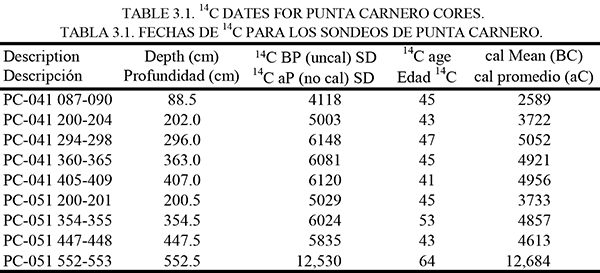
Same table, in print-ready format.
Preparation of Tables for Books
Tables do not normally include material prepared as graphic images by authors. They are text and numbers organized in rows and columns rather than paragraphs. Like illustrations, tables should never be included in the manuscript (text files). Each should be a separate spreadsheet file (XLS or XLSX), not a word processor "table" document.
Like figures, all tables must be referred to in the text and numbered in the order they are referred to (usually Table 1.1 for the first in Chapter 1, etc.). Tables also will be printed only once in bilingual publications. Any text, aside from proper names, must be present in both languages, and this should be borne in mind when tables are being prepared.
A brief, but clear description of the table should follow the table label (e.g., Table 1.1.) on the top cell running across the width of the table. For example: "Table 1.1. Diagnostic sherd counts from excavation units in Area B", followed in the cell below it by its translation (if in Spanish, "Tabla 1.1. Conteo de tiestos diagnósticos provenientes de las unidades de excavación en el Area B").
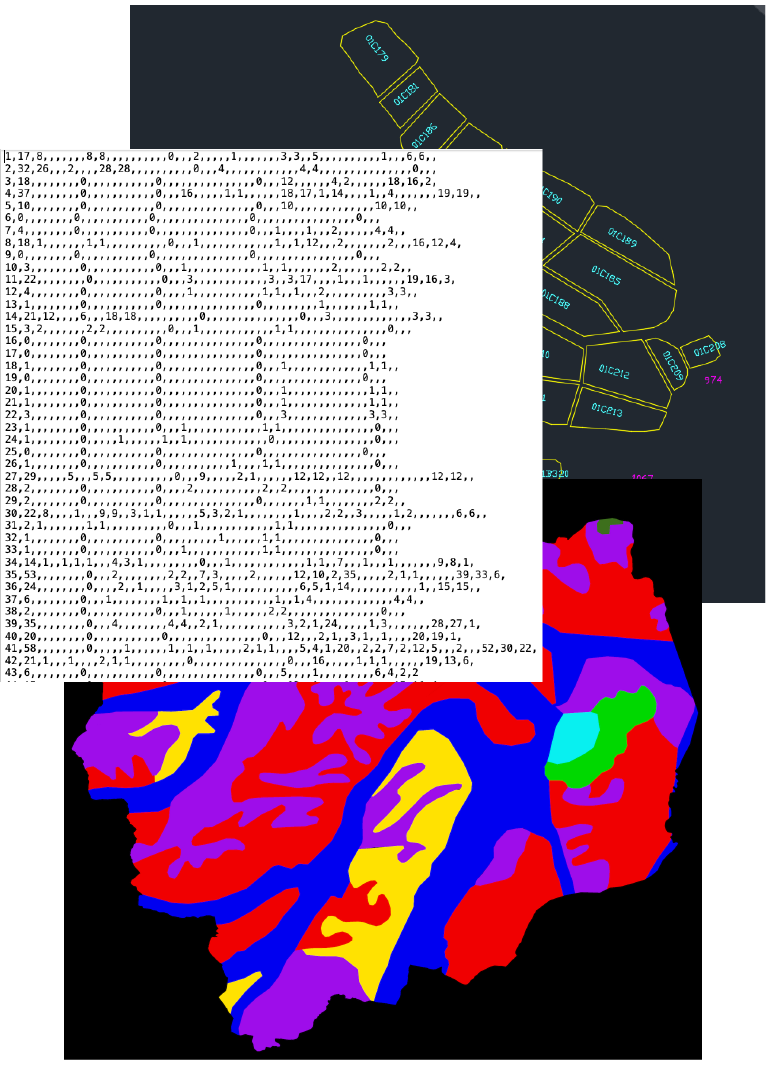
The Comparative Archaeology Database
The Comparative Archaeology Database complements books in traditional format, and this is where we now make available most of the detailed data that have traditionally appeared as large tables, figures, and descriptions in printed volumes. Such material is usually difficult or expensive to publish on paper but economical and advantageous to make available electronically in a variety of formats. Such material could include, but is not limited to, quantitative data that is most readily utilized by importing to a database or statistical analysis program; map data that might most easily be used by importing into a GIS program; numerous graphics, especially in color; voluminous and detailed data and descriptions of many kinds. A book should be self-contained, including all information needed to understand how the conclusions were reached, but detailed supporting data will be presented in the online database.
Preparation of material destined for the Comparative Archaeology Database will require close collaboration between Center publications staff and authors, because the nature of this material is highly varied. Such collaboration should begin before much work is invested in the preparation of this material. In general, however, text should be in very plain word processor (DOC) files. Tables should be in spreadsheet XLS files. Line drawings should be in the native file formats of the programs used to prepare them (AI for Illustrator, DWG for AutoCAD, etc.). Photographs may be TIF or JPG files.